Foundations of Algebra
| Solving One-Step Equations |
|
A one-step equation is as straightforward as it sounds. You will only need to perform one step in order to solve the equation. One goal in solving an equation is to have only variables on one side of the equal sign and numbers on the other side of the equal sign. The other goal is to have the number in front of the variable equal to one. The strategy for getting the variable by itself with a coefficient of 1 involves using opposite operations. For example, to move something that is added to the other side of the equation, you should subtract. The most important thing to remember in solving a linear equation is that whatever you do to one side of the equation, you MUST do to the other side. So if you subtract a number from one side, you MUST subtract the same value from the other side. You will see how this works in the examples. We’ll begin solving equations with those that only require one-step. Once you work through the examples, you may want to link to other lessons that require more steps. Let's Practice:
- Solve

Remember the goal is to have the variable by itself on one side of the equation. In this problem, that means moving the 5 to the other side of the equation. Since the 5 is added to the variable, we move it to the other side of the equation by subtracting 5. However, if we subtract 5 from the left side of the equation, we MUST also subtract 5 from the right side.

- Solve

It does not matter that the variable in this equation is on the right side of the equation. The position of the variable is not an issue. Remember that the goal is to have the variable on one side by itself. It does not matter which side.
To get the variable by itself, we need to add 3 to both sides.

- Solve

The variable in this equation is already on one side of the equation by itself. There is no need to add or subtract anything to both sides. However, the number in front of the variable is not 1. The -3 that is in front of the variable indicates multiplication of -3 by x. The opposite operation of multiplication is division. So we will divide both sides by -3.

You should take note of the different ways of writing the answer. In the example, we divided by -3, yet wrote the answer with the negative in front of the entire fraction, not just the 3. Each of the following fractions all mean the same thing.

- Solve

The variable in this equation is already on one side by itself, but it is divided by 3. To get rid of the 3 that is attached to the variable by division, we will perform the opposite operation which is multiplication. Notice that our variable can be any letter. It does not always have to be x.

- Solve

Once again, the variable is on one side by itself, but is multiplied by a -3 and divided by 5. Let’s take care of each operationseparately and see what happens. First we’ll get rid of the 5 by multiplying both sides by 5. Then we’ll get rid of the -3 by dividing both sides by -3.

Rather than perform two separate steps of multiplying by 5 and then dividing by -3, it is possible to combine those operations into one step. In other words, we can multiply both sides by  . The value . The value  is called the reciprocal of is called the reciprocal of  . The reciprocal of a number has the same sign, but the numerator and denominator are reversed. So what was on bottom, is now on top. And what was on top, is now on bottom. . The reciprocal of a number has the same sign, but the numerator and denominator are reversed. So what was on bottom, is now on top. And what was on top, is now on bottom.
If we re-work Example 5 by using the reciprocal, you can see that it will save a step in the solution process.

Each of these examples has only required one step (addition, subtraction, multiplication, or division) in order to solve it. Click on these links to learn more about solving equations with two steps or more.
http://www.algebralab.org/lessons/lesson.aspx?file=algebra_onevariableonestep.xml
|
|
Anatomy
Definition of Reflex
Have you ever burnt yourself on a stove? What happened when you put your hand on the stove when it was hot? Did you have to say, 'Wow that is hot; I need to remove my hand!'? No! You moved your hand immediately because of a reflex. Reflex, or reflex action, is the involuntary movement of any organ or body part that has received a stimulus. It happens without any consciousness and is immediate. Reflexes protect the body from harm.
So, how did that reflex happen after you touched the stove? In your hand are nerve endings that pick up a stimulus and carry it to the spinal column and brain. The nerve ending (in this case of burning your hand) is called a sensory neuron (also known as an afferent neuron) because it takes the stimulus - heat to the hand - to the spinal column and brain for interpretation. The brain then interprets the stimulus and sends a message back to the muscles in the hand by a motor neuron (also called an efferent neuron).
The process of the sensory neuron carrying the stimulus to the spinal column and brain, and then the brain sending a message to the motor neuron is called a reflex arc.
Types of Reflexes
There are several ways to classify the types of reflexes in the body.
First, let's talk about the type or function of reflex. Reflexes can be classified according to the type and function of the muscles or organs that move or function because of the reflex. Some reflexes that move skeletal muscles are called: flexor, extensor, locomotor, and statokinetic. Reflexes that involve functions of internal organs include digestive, cardiovascular, excretory, and secretory.
Next, we can talk about the degree of complexity of the reflex. Reflexes are classified according to the degree of complexity of the neuron (nerve) organization within the reflex arcs. In this classification, there are monosynaptic (or monosegmental) reflexes, which involve only one segment of the central nervous system, and multisynaptic (or intersegmental) reflexes, which involve more than one segment of the central nervous system.
So, let's dive into this topic a bit more. You probably already know that mono means one and multi means more than one. But, what does that mean in relation to synapses? Monosynaptic means there is only one neuron involved each way on the path to the spinal cord (called an afferent or sensory neuron) and one away from the spinal cord (called an efferent or motor neuron). An example of a monosynaptic reflex is the patellar (knee jerk) reflex.
A multisynaptic reflex, as you can guess, is more complex. In the simplest form, a multisynaptic reflex has more than one neuron (called interneurons) within the reflex arc process. It also involves more than one area of the central nervous system - usually the spinal cord and the brain. An example of this type is the flexor reflex.
Finally, let's look at the influence on muscle or organ of the reflex. Reflexes can have an excitatory (often known as facilitating) action or an inhibitory (weakening and suppressing) activity. For example, we can examine the reflex actions on the heartbeat. The excitatory reflex of the sympathetic nerve will increase the heartbeat. To decrease the heartbeat, or even stop the heartbeat, the vagus nerve is the inhibitory reflex.
Common Reflexes and Examples
The stretch reflex is one of the simplest reflexes and is monosynaptic. It contracts a muscle that is being stretched and contributes to balance and coordination. A deep tendon reflex is an example of a stretch reflex. How does this work? When you're standing up, your knees bend slightly, and without the deep tendon reflex located around your knees, you could fall. That reflex will straighten your knees and keep you standing upright if you lose your balance. Aside from the knees, deep tendon reflexes are located along the outside of your elbows, in the crooks of your arms, and at your wrists and ankles. This is the same reflex that the doctor checks around your knee.
When the knee is tapped with the hammer, it takes about 50 milliseconds before the leg kicks. That is really fast! When the doctor tapped the hammer, it caused the thigh muscle to stretch. That stretch information is then sent to the spinal cord via the sensory neuron. After one synapse in the spinal cord, the information is sent back out to the thigh muscle via the motor neuron that then makes the thigh contract. A few more examples of this type of reflex include blinking your eye when something gets close to it or raising your hands to your face when a ball is thrown at you. Shivering when you are cold is also an example of the stretch reflex.
http://study.com/academy/lesson/reflex-definition-types-examples.html
Geometry
Formulas for Angles in Circles
1. Central Angle
A central angle is an angle formed by two radii with the vertex at the center of the circle.
Central Angle = Intercepted Arc
|
In the diagram at the right, ∠AOB is a central angle with an intercepted minor arc from A to B.
m∠AOB = 82º
|
|
 In a circle, or congruent circles, congruent central angles have congruent arcs.(the converse is also true) In a circle, or congruent circles, congruent central angles have congruent arcs.(the converse is also true)
|
 In a circle, or congruent circles, congruent central angles have congruent chords. (the converse is also true) In a circle, or congruent circles, congruent central angles have congruent chords. (the converse is also true)
|
|
|
2. Inscribed Angle
An inscribed angle is an angle with its vertex "on" the circle, formed by two intersecting chords.
Inscribed Angle =  Intercepted Arc Intercepted Arc
|
In the diagram at the right, ∠ABC is an inscribed angle with an intercepted minor arc from A to C.
m∠ABC = 41º
|
|
|
|
|
3. Tangent Chord Angle
An angle formed by an intersecting tangent and chord has its vertex "on" the circle.
Tangent Chord Angle =  Intercepted Arc Intercepted Arc
|
In the diagram at the right, ∠ABC is an angle formed by a tangent and chord with an intercepted minor arc from A to B.
m∠ABC = 74º
|
|
|
4. Angle Formed by Two Intersecting Chords
|
When two chords intersect inside a circle, four angles are formed. At the point of intersection, two sets of congruent vertical angles are formed in the corners of the X that appears.
Angle Formed by Two Chords
=  (SUM of Intercepted Arcs) (SUM of Intercepted Arcs)
|
In the diagram at the right, ∠AED is an angle formed by two intersecting chords in the circle. Notice that the intercepted arcs belong to the set of vertical angles. also, m∠BEC = 43º (vertical angle) also, m∠BEC = 43º (vertical angle)
m∠CEA and m∠BED = 137º by straight angle formed.
|
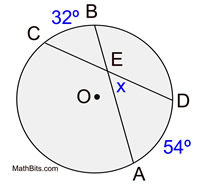
Once you have found ONE of these angles, you automatically know the sizes of the other three by using vertical angles (which are congruent) and adjacent angles forming a straight line (whose measures add to 180º).
|
|
|
5. Angle Formed Outside of Circle by Intersection: "Two Tangents" or "Two Secants" or a "Tangent and a Secant".
The formulas for all THREE of these situations are the same:Angle Formed Outside =  ( DIFFERENCE of Intercepted Arcs)
|
|
∠ ABC is formed by two tangents intersecting outside of circle O. The intercepted arcs are major arc  and minor arc  . These two arcs together comprise the entire circle.
Angle Formed by Two Tangents
=  (DIFFERENCE of Intercepted Arcs) (DIFFERENCE of Intercepted Arcs) (When subtracting, start with the larger arc.) (When subtracting, start with the larger arc.)
|
|
|
Note: It can be proven that ∠ABC and central angle ∠AOC are supplementary.
Thus the angle formed by the two tangents and the degree measure of the first minor intercepted arc also add to 180º
|
|
|
∠ CAE is formed by two secants intersecting outside of circle O. The intercepted arcs are major arc  and minor arc  .
Angle Formed by Two Secants
=  (DIFFERENCE of Intercepted Arcs) (DIFFERENCE of Intercepted Arcs) (When subtracting, start with the larger arc.) (When subtracting, start with the larger arc.)
|
|
|
|
|
|
∠ BAD is formed by a tangent and a secant intersecting outside of circle O. The intercepted arcs are arc  and arc  .
Angle Formed by Tangent and Secant
=  (DIFFERENCE of Intercepted Arcs) (DIFFERENCE of Intercepted Arcs) (When subtracting, start with the larger arc.) (When subtracting, start with the larger arc.)
|
|
https://mathbitsnotebook.com/Geometry/Circles/CRAngles.html
|
|
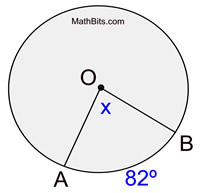
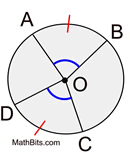

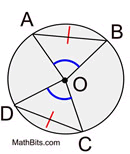



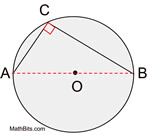
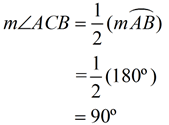
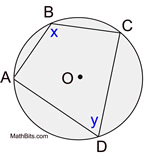
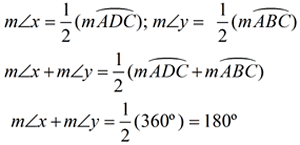
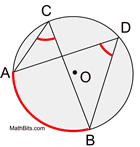
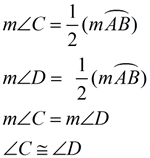






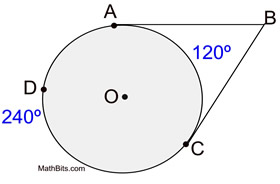
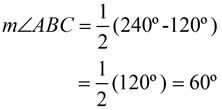

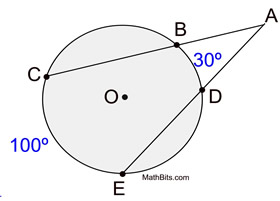


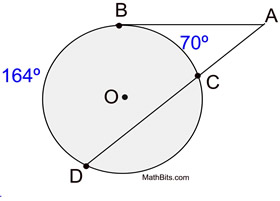
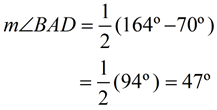
No comments:
Post a Comment